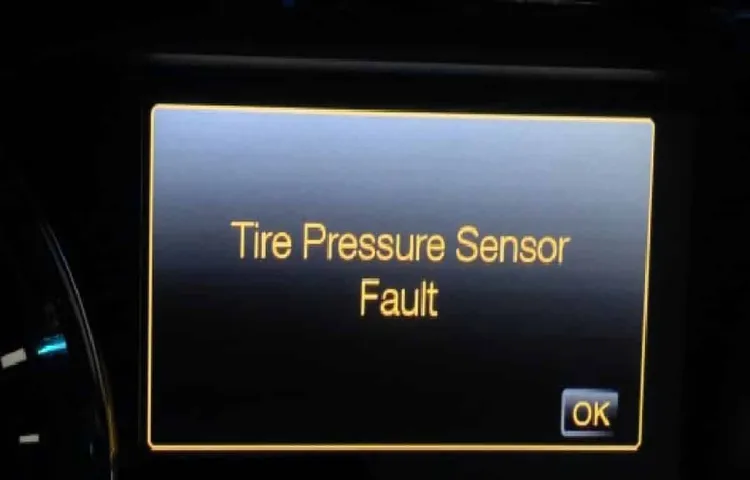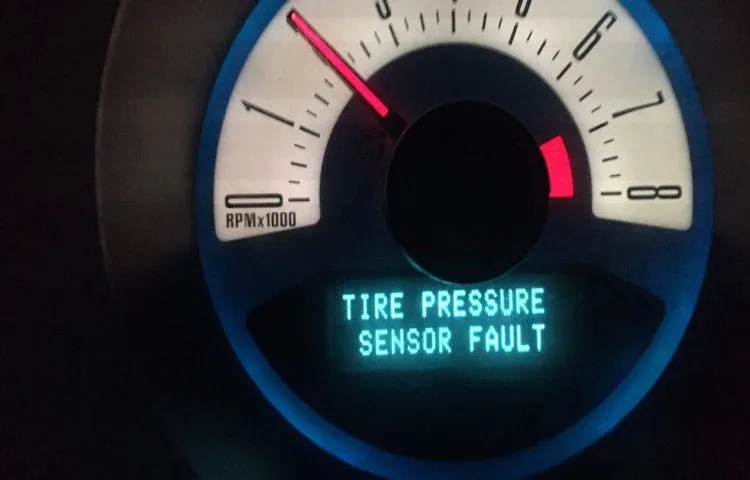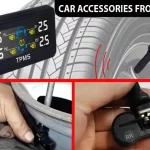Have you ever been driving down the road only to have a mysterious tire pressure warning light appear on your car’s dashboard? It can be frustrating and confusing, especially if you’re unsure about what it means. Tire pressure sensors are important safety features that help you maintain proper inflation levels in your tires. While they can help ensure your vehicle operates efficiently, they can also trigger annoying warning lights when issues arise.
In this blog, we’ll discuss common tire pressure sensor faults and how to troubleshoot them. Get ready to learn how to handle this pesky problem and keep your wheels turning smoothly.
Table of Contents
What Is a Tire Pressure Sensor?
If you ever see a message pop-up on your car dashboard saying “Tire Pressure Sensor Fault,” then it means that there might be an issue with the tire pressure sensors located in your vehicle’s tires. These tire pressure sensors are responsible for monitoring the air pressure within your car’s tires and alerting you if there is a deflate or over-inflation problem. A Tire Pressure Monitoring System (TPMS) is used to connect all of the sensors and transmit the pressure readings to your car’s computer.
If the system detects that a pressure is too low or too high, the TPMS activates the warning light on your car dashboard. If you need to replace a tire pressure sensor, it is recommended that you visit a certified mechanic to ensure the TPMS system is functioning properly.
Why Do You Need One?
Tire Pressure Sensor Do you want to ensure the safety of your car and keep your tires in good condition? A tire pressure sensor could be the answer! A tire pressure sensor is a device installed in your car’s wheels that measures the air pressure in your tires and sends real-time data to your car’s computer. This information is crucial in maintaining proper tire pressure to prevent accidents, flat tires, and blowouts while driving. The sensor also helps improve gas mileage, reduces tire wear and tear, and provides peace of mind for drivers.
It acts as an early warning system, alerting drivers to low tire pressure before it becomes a significant issue. Think of it as a personal doctor monitoring your vitals and informing you when there’s a problem. It’s a small but essential component that can make a significant difference in your driving experience and the lifespan of your vehicle.
So, if you’re someone who values safety and efficiency, investing in a tire pressure sensor is a no-brainer.

What Is a Tire Pressure Sensor Fault?
If you’re driving along and suddenly see a message that reads “tire pressure sensor fault” pop up on your dashboard, it can be quite alarming. However, it’s not necessarily cause for panic. Essentially, this message means that there is an issue with one or more of the sensors in your vehicle’s tire pressure monitoring system (TPMS).
This system is designed to alert you when the pressure in your tires is too low, which can impact your vehicle’s performance and safety. A fault in the sensor could mean that it’s not functioning correctly and may either give you false warnings or not alert you to a real issue. It’s important to get this issue addressed as soon as possible to ensure that your TPMS is working properly and keeping you safe on the road.
What Triggers the Fault Warning?
If you’ve ever seen the warning light for a tire pressure sensor fault on your car’s dashboard, you might be wondering what triggers it. Essentially, the tire pressure sensor is a small electronic device that’s located inside the tire. It constantly monitors the air pressure within the tire and sends that information to the car’s computer.
If the sensor detects a drop in pressure or a problem with its own function, it will trigger the warning light. This means that you need to check your tire pressure and either inflate your tires or visit a mechanic to get the sensor fixed. Keep in mind that driving on underinflated tires can be dangerous and cause blowouts or accidents on the road.
So, it’s always important to take care of any tire pressure sensor faults as soon as possible to keep yourself safe on the road.
Common Causes of a Faulty Sensor
A tire pressure sensor fault is a common problem that many drivers encounter. It occurs when the sensor that is responsible for monitoring the air pressure in your tires malfunction. The main cause of a faulty sensor is damage or wear and tear.
This can happen due to a range of reasons, such as debris on the road or driving on rough terrain. Another cause is exposure to extreme weather conditions like extreme cold or heat. In addition, a tire pressure sensor fault can also happen due to age as the sensor begins to deteriorate over time.
If left unchecked, this can lead to inaccurate tire pressure readings, which can be dangerous and result in accidents. Therefore, it is crucial to have your sensor checked regularly and replaced if necessary to ensure your safety on the road.
Impacts of Ignoring a Tire Pressure Sensor Fault
A tire pressure sensor fault is a warning that your vehicle’s tire pressure monitoring system (TPMS) has detected an issue with one or more of your tires. This typically happens when one or more of your tires are underinflated, overinflated, or has sustained damage. Ignoring this fault could result in a variety of negative impacts on your vehicle’s performance and safety.
First and foremost, driving with underinflated tires will decrease your vehicle’s fuel efficiency, causing you to spend more money on gas over time. Additionally, low tire pressure can cause your tires to wear unevenly, leading to premature tire wear and costly replacements. More importantly, driving with underinflated tires can also increase your risk of a blowout, which can be extremely dangerous at high speeds.
Therefore, it is critical to address these issues as soon as they arise and have your tire pressure checked regularly to ensure your vehicle is running smoothly and safely.
How to Fix a Tire Pressure Sensor Fault?
If you see a “tire pressure sensor fault” message on your dashboard, it means that the sensor that measures the air pressure in your tires is not working correctly. This can be caused by a few different things, such as a dead battery in the sensor, a damaged sensor, or even just a loose connection. To fix the issue, the first thing you should do is check the air pressure in your tires to make sure they are all inflated to the recommended level.
If they are, you may need to take your vehicle to a mechanic or dealer to have the sensor inspected and replaced if necessary. It’s important to address the issue promptly because driving with a faulty tire pressure sensor can lead to uneven tire wear, poor handling, and even increased risk of a blowout. Always pay attention to your vehicle’s warning messages and have any issues addressed as soon as possible to ensure your safety on the road.
Professional Fixes
Tire Pressure Sensor Fault If your car’s tire pressure sensor is malfunctioning, the first thing you’ll notice is the warning light on your dashboard. This can be frustrating, but it’s important to address the issue to avoid potential safety hazards. The most common cause of a tire pressure sensor fault is a dead or dying battery within the sensor.
This occurs because the sensor is constantly sending data to the car’s computer, which drains the battery over time. To fix this issue, you can take your car to a professional mechanic who can replace the faulty tire pressure sensor. Alternatively, you can purchase a new sensor and replace it yourself if you have the proper tools and knowledge.
Keep in mind that if one sensor has failed, others may follow suit due to similar aging and stress. It’s also important to note that a tire pressure sensor fault can sometimes be caused by low tire pressure or a punctured tire. In this case, simply filling up your tires with air or getting the tire repaired can solve the issue.
However, if the warning light persists even after the tire has been fixed, it’s likely a problem with the sensor itself. Overall, addressing a tire pressure sensor fault can be a simple fix, but it’s essential to ensure the safety of yourself and others on the road by getting it resolved promptly.
DIY Fixes and Maintenance Tips
Are you worried about a tire pressure sensor fault in your vehicle? Don’t worry, it’s a common issue. These sensors are responsible for giving you real-time updates on tire pressure. But when they fail, it can be frustrating to deal with.
The first step is to identify the issue properly. Check your tire pressure manually with a gauge and compare it with what the sensor is displaying. If there’s a significant difference, it’s time to examine your sensor.
In some cases, the issue might be due to low battery power, which can be resolved by replacing it. However, it’s best to have a professional mechanic examine the sensor to ensure there are no severe damages. By fixing your tire pressure sensor fault, you can ensure your safety and prevent unnecessary tire wear and tear.
Final Thoughts
If you see a message on your car’s dashboard that says “tire pressure sensor fault,” it means that there is an issue with one or more of the sensors that are responsible for monitoring your tire pressure. These sensors are mounted inside the tire and measure the air pressure, sending this information to a receiver on the vehicle. When one of these sensors fails or is malfunctioning, it can cause inaccurate readings, leading to warning signals.
If you ignore this fault message, it could lead to reduced fuel efficiency, decreased overall tire life, reduced handling, longer stopping distances, and an increased risk of a blowout or tire failure. Therefore, it is essential to have a professional mechanic to diagnose and repair or replace the affected tire pressure sensor as soon as possible to ensure your safety and extend the lifespan of your car’s tires.
Conclusion
In the world of car diagnostics, the term ‘tire pressure sensor fault’ may sound like a daunting message from your vehicle. However, fear not! This simply means that your car’s built-in sensor system has detected an issue with the tire pressure readings. With modern technology at our fingertips, such messages serve to remind us of the importance of maintaining a proper tire pressure for optimal driving performance.
So, next time you receive this message, take it as a friendly nudge to give your tires some love and attention to keep your journey smooth and safe.”
FAQs
What is a tire pressure sensor fault?
A tire pressure sensor fault is an error message that appears on a car’s dashboard when there is an issue with the tire pressure monitoring system. It indicates that one or more of the sensors that detect tire pressure is not functioning properly.
How do I know if my tire pressure sensor is faulty?
You can tell if your tire pressure sensor is faulty if you see the warning light on your dashboard indicating a tire pressure issue. Additionally, if you notice your tires are losing pressure frequently or if the sensor readings are not accurate, you may have a faulty sensor.
Can I still drive my car if the tire pressure sensor is faulty?
While it’s technically possible to drive a car with a faulty tire pressure sensor, it’s not recommended. The sensor helps you to maintain the appropriate tire pressure, which is crucial for your safety on the road. It’s best to address the issue as soon as possible.
How much does it cost to fix a tire pressure sensor fault?
The cost of fixing a tire pressure sensor fault can vary depending on the make and model of your vehicle, as well as the extent of the damage. On average, it can cost anywhere from $50 to $250 to replace a sensor.
Can I replace the tire pressure sensor myself?
While it’s technically possible to replace a tire pressure sensor on your own, it requires specialized tools and knowledge. It’s best to seek the help of a professional mechanic to do the replacement to ensure the job is done safely and accurately.
How often do tire pressure sensors need to be replaced?
Tire pressure sensors do not have a specific lifespan, but they can fail due to wear and tear, battery failure, or exposure to harsh conditions. Generally, they can last from 5 to 10 years before needing to be replaced.
How do I prevent tire pressure sensor faults from occurring?
To prevent tire pressure sensor faults, make sure you check your tire pressure regularly and keep the appropriate tire pressure as recommended by your vehicle’s manufacturer. Additionally, avoid hitting curbs or potholes, as this can damage the sensors. Finally, avoid exposing the sensors to extreme temperatures or harsh conditions.



